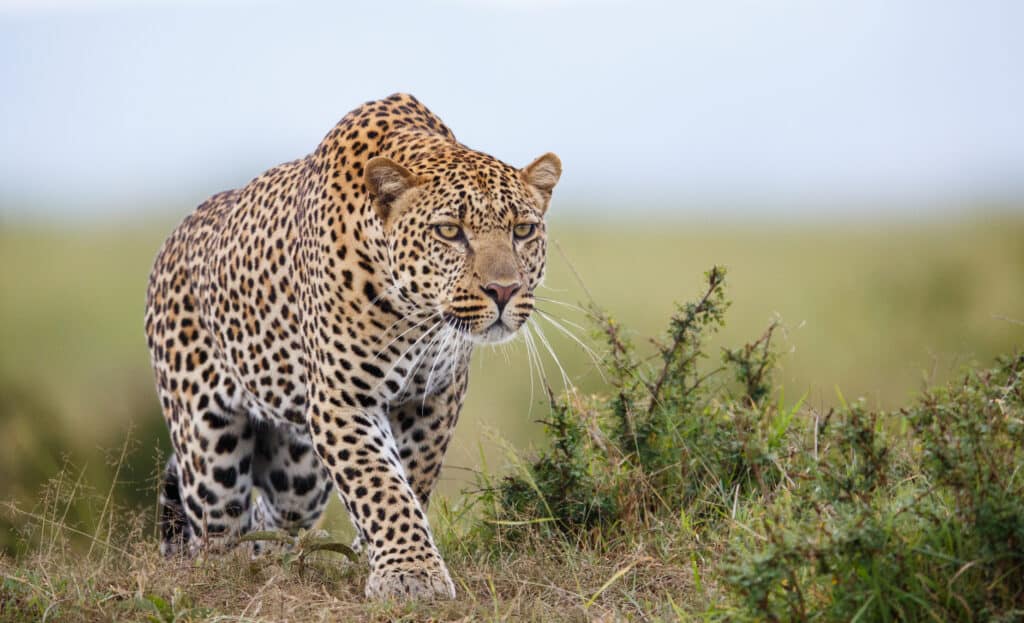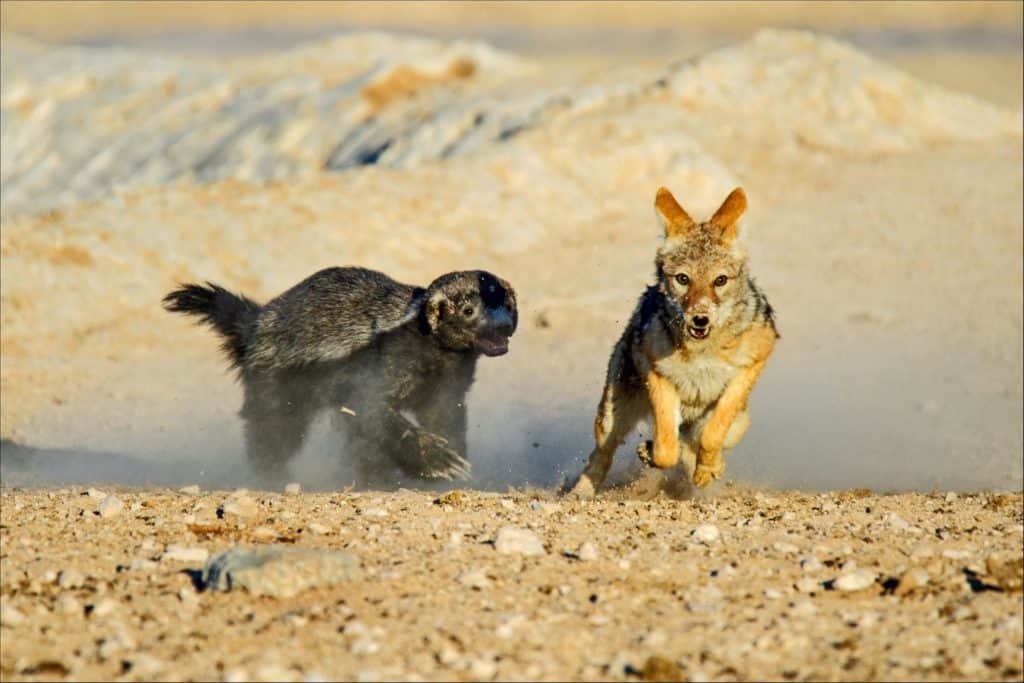Honey badgers have been mythologized for their toughness and combat abilities. They’re certainly capable of dispatching some deadly animals, including venomous snakes. That does not mean they could take on any apex predator in the animal kingdom. Discover how a honey badger vs. leopard fight would play out and find out which of these two mammals would survive!
Comparing a Honey Badger and a Leopard

| Honey Badger | Leopard | |
|---|---|---|
| Size | Weight: between 11 and 40 pounds Length: from 1.5 to 2.5 feet | Weight: roughly 70 to 200 pounds Length: about 3.5 to 6 feet from nose to tail Height: from 2 to 2.3 feet |
| Speed | – Between 15 and 20 mph | – Between 35 and 40 mph |
| Defenses | – Have thick skin, measuring about ¼ inch, which helps them take serious damage – The skin is loose and elastic, making it hard for enemies to grab them – They can emit a horrible-smelling secretion from their anal glands to ward off enemies | – Leopards have a fair amount of speed to get away from danger – Their fur can help them blend into their environment, making them hard to spot – These animals can easily climb trees to escape danger and hide from other predators |
| Offensive Capabilities | – Have teeth that measure about 1.5 inches long – Their jaws are powerful, helping them break bones and even tortoise shells – Claws measure 1.5 inches long, and they’re capable of using them for defense | – Have a somewhat powerful bite that can reach 300 to 320 psi – They have very sharp claws they use to climb – Leopards have strong legs that help them carry prey up trees |
| Predatory Behavior | – Pursue and kill their prey – May even pursue and dig prey out of their burrows | – These animals ambush their prey or stalk and attack them when they’re close – Typically kills prey by biting the head or neck |
What Are 2 Key Differences Between a Honey Badger and a Leopard?

Leopards tend to live for between ten and fifteen years in the wild, depending on the habitat and the food supply available.
©iStock.com/UrmasPhotoCom
Although both leopards and honey badgers are quadrupedal carnivores, they differ a great deal in terms of their size and predatory behaviors. Honey badgers are small animals, weighing between 11 and 40 pounds and growing from 1.5 to 2.5 feet long, but leopards weigh between 70 and 200 pounds and grow up to 6 feet long. Meanwhile, honey badgers are pursuit predators willing to dig their prey out of their burrows to kill them, but leopards are ambush predators that rely on waiting until the right moment to use a single deadly bite to kill their prey.
These elements will have a major impact on the outcome of the fight, but these factors are not the only ones that matter in a battle between the two creatures.
What Are the Key Factors in a Fight Between a Honey Badger and a Leopard?

Honey badgers can scare off larger animals with their fierce attitude.
©Dirk Theron/Shutterstock.com
A total of 5 key factors usually impact the outcome of any fight in the animal kingdom. These include the size, speed, defenses, offenses, and predatory abilities of the combatants. This fight is no different. This section will compare the animals according to these elements and determine which of them has the edge in each. Then, with all 5 facets of the fight explored, we’ll combine our new understanding of the animals to determine how this fight ends.
Honey Badger vs .Leopard: Size
Leopards are far larger than honey badgers. On average, a leopard weighs anywhere from 70 to 200 pounds, grows about 3.5 to 6 feet long, and stands 2 to 2.3 feet tall. Meanwhile, the honey badger only weighs between 11 and 40 pounds and grows about 1.5 to 2.5 feet long. They’re rather small creatures.
Leopards have the size advantage in this case.
Honey Badger vs. Leopard: Speed
The average honey badger has a maximum speed of 15 to 20 miles per hour. So, they are both reasonably fast as well as very agile animals. Meanwhile, leopards have a top speed of about 40 miles per hour. They don’t have as much burst speed as some of the other big cats, but they make up for it with their stalking prowess.
Leopards have the speed advantage in this bout.
Honey Badger vs. Leopard: Defenses
Leopards are not the largest predators in their range. Instead of relying on their size or living in a group to stay safe, they rely on stealth and cunning. Their fur coloration helps them blend into their surroundings, and their ability to climb trees helps them escape adverse conditions and keep their food safe from thieves. Their speed is also useful in avoiding encounters that don’t favor them.
Meanwhile, the honey badger has more physical defenses. Their thick skin is about a quarter of an inch thick, and it is loose and somewhat elastic. That makes it hard for animals to bite down on them. Even if an animal catches the honey badger in its jaws, the honey badger can twist around and deliver a counterattack. They can also emit a foul-smelling secretion from their anal glands to drive other animals away.
Honey badgers have the advantage in defenses in this fight.
Honey Badger vs. Leopard: Offensive Capabilities
Leopards are like other big cats in that they rely on their bites to kill their prey. However, their bite is not as strong as lions or jaguars. Still, they can muster a bite power of between 300 and 320 PSI. When hunting, they’ll aim that bite and their 2-inch-long teeth at the head or neck of their prey, dispatching the animal. These mammals also have sharp claws that help them climb trees, which is helpful because they often drag their dead prey into trees where they can eat them without other animals interfering.
Honey badgers are more powerful than their size suggests. Their teeth can get 1.5 inches long, and their jaws are strong enough to break apart tortoise shells. They also have claws that grow about 1.5 inches long, and they’ll use them when fighting and to help them dig into the ground in pursuit of prey.
Leopards have the advantage in offensive capabilities.
Honey Badger vs. Leopard: Predatory Behavior
Leopards are stealthy hunters that ambush their prey when they get close enough to them. These cats will often wait in trees for prey to get close enough before attacking. Other times, they’ll stalk their prey, eventually getting close enough to attack. Once they begin their assault, they seek to end the battle with a bite to the neck or head.
The honey badger is a pursuit predator and somewhat of an opportunist. They’ll spot and pursue prey, or they will use their senses to find them and dig them out of their burrows.
Leopards have the advantage in terms of predatory behavior.
Who Would Win in a Fight Between a Honey Badger and a Leopard?

The leopard would easily win this fight if it was seriously dedicated to killing the honey badger.
©Dmitri Gomon/Shutterstock.com
A leopard would win a fight against a honey badger. Despite legends of the smaller creature’s supposed immortality, a honey badger is not equipped to win a fight against a leopard. Sure, the internet has some videos of a honey badger scaring off leopards who decide the fight isn’t worth their effort.
For every one of those encounters, there are probably two where the leopard swoops in and kills the honey badger. That’s not to say the honey badger can’t put up a fight, doing its best to musk, bite, and scratch the leopard.
However, if the leopard is truly intent on killing and eating the honey badger, it will leverage its hunting abilities, weight, and strength to pin and kill the smaller mammal with a strong bite to the animal’s head.
The photo featured at the top of this post is © Erwin Niemand/Shutterstock.com
Thank you for reading! Have some feedback for us? Contact the AZ Animals editorial team.







